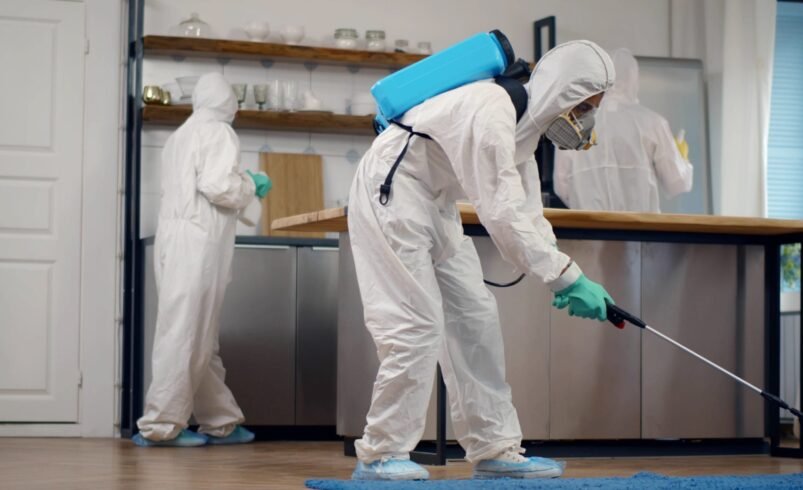How to Advertise Pest Control: A Complete Marketing Guide

Running a pest control company means going head-to-head with dozens of local businesses, all competing for the same frustrated homeowners and anxious business owners. When someone discovers ants marching across their kitchen counter or hears scratching in their walls at 2 AM, you want them calling you, not your competition.
The key? A rock-solid advertising strategy that meets customers where they’re already looking for help. While traditional methods, such as door hangers and Yellow Pages ads, still have their place, today’s pest control market is largely online. That’s exactly where your business needs to dominate.
This comprehensive guide breaks down how to advertise pest control services effectively, explores the professional terminology that builds trust, identifies which businesses benefit most from SEO investment, defines your target market, and analyzes current pest control industry trends so you can stay three steps ahead of the competition.
What Is the Professional Term for Pest Control?
When speaking with potential clients, especially commercial accounts, the words you choose matter more than you might think. In professional and commercial contexts, pest control is often called “pest management” or “integrated pest management (IPM).” These terms signal a strategic, science-based approach rather than a quick-fix extermination service.
Pest Management: A comprehensive service category covering extermination, prevention, and ongoing monitoring. It suggests you’re solving the root problem, not just treating symptoms.
Integrated Pest Management (IPM): A long-term strategy combining biological, cultural, physical, and chemical solutions to reduce pest risks in an environmentally responsible way. This approach appeals to eco-conscious customers and businesses with strict safety requirements.
Using these professional terms in your marketing materials instantly elevates your brand. Instead of advertising “pest control,” position yourself as a “pest management professional” or “IPM specialist.” This subtle shift communicates expertise and professionalism, qualities that justify higher prices and build long-term client relationships.
Which Businesses Need SEO Most?
Every business can benefit from search engine optimization, but certain industries rely on it for their very survival. Service-based, local businesses where customers search online first, that’s where SEO becomes absolutely critical. Pest control sits right at the top of this list.
Here’s why Pest Control SEO is non-negotiable:
→ High Local Search Volume: Homeowners frantically search “exterminator near me,” “pest control [your city],” or “emergency pest removal” when they discover unwelcome visitors. Ranking at the top of these searches drives immediate, high-intent traffic to your business.
→ Emergency-Driven Mindset: Unlike shopping for a new TV or planning a vacation, pest problems demand immediate action. Customers call the first company they find online. If that’s not you, it’s money walking straight into your competitor’s hands.
→ Recurring Revenue Potential: Many pest issues require ongoing treatments, such as monthly, quarterly, or seasonal service contracts. Strong SEO doesn’t just generate one-time sales; it builds a foundation for predictable, recurring income.
Other service industries that rely heavily on local SEO include plumbers, electricians, HVAC companies, landscapers, and locksmiths. Any business where location, timing, and immediate need intersect.
For pest control companies serious about growth, partnering with SEO specialists like IronChess SEO can transform your online visibility. They understand the local service industry and know exactly how to get your company ranking above competitors when customers need help most.
Who Is Your Target Market for Pest Control?
Understanding your ideal customers shapes every aspect of your advertising strategy, from ad copy to keyword targeting and service pricing. Pest control services appeal to diverse audiences, but four main segments drive the majority of revenue:
Homeowners and Renters
This represents your largest potential market. These customers focus on solving immediate problems, such as ants in the kitchen, termites threatening their foundation, roaches in the bathroom, or mice in the garage. They respond well to local SEO, emergency-focused advertising, and before-and-after success stories that show real results.
Property Managers and Landlords
These clients need reliable, recurring pest control across multiple rental properties. They value long-term service contracts, fast response times, and detailed documentation for tenant complaints. Property managers often make decisions based on cost-effectiveness and reliability rather than the cheapest price.
Commercial and Business Clients
Restaurants, hotels, warehouses, retail stores, and food processing facilities represent high-value accounts. These businesses require regular, proactive pest management to comply with health department regulations and maintain a good reputation. They’re typically willing to pay premium rates for guaranteed results and comprehensive service contracts.
Government and Institutional Accounts
Schools, hospitals, government buildings, and municipal facilities require certified, bonded pest control providers with proven experience in compliance. These contracts often involve lengthy bidding processes but provide steady, long-term income.
When creating advertising campaigns, tailor your message to each audience segment. Homeowners need “fast emergency pest control,” while property managers want “comprehensive pest management solutions for multi-unit properties.”
Understanding Pest Market Trend Analysis
A pest market trend analysis examines how the industry evolves, what drives customer decisions, how competitors position themselves, and where new opportunities emerge. For pest control companies, this analysis is crucial because market dynamics shift with weather patterns, regulations, economic conditions, and emerging pest threats.
Key Trends Shaping the Industry:
→ Seasonal Demand Cycles: Pest control demand spikes dramatically during warmer months when insects and rodents are most active. Smart companies ramp up advertising spend in spring and summer while using winter months for equipment maintenance and customer retention.
→ Health and Safety Awareness: Increased concern about vector-borne diseases (Zika, Lyme disease, West Nile virus) drives more customers to seek professional pest management. Marketing that emphasizes health protection resonates strongly with families.
→ Eco-Friendly Solutions: Growing environmental consciousness creates demand for non-toxic, pet-safe, and organic pest control methods. Companies offering green alternatives often command higher prices and attract environmentally conscious customers.
→ Technology Integration: Smart monitoring systems, digital reporting, and automated treatment scheduling are becoming standard in commercial accounts. Companies that embrace technology can differentiate themselves and streamline operations.
→ Mobile-First Consumer Behavior: Customers now read reviews, check Google ratings, compare prices, and book services entirely on mobile devices. Your website, booking system, and payment processing must work flawlessly on smartphones.
By monitoring these trends, you can adjust marketing campaigns for maximum impact. For example, launching aggressive local SEO campaigns in early spring ensures your business captures demand when it peaks.
Visual Content Suggestions
To maximize engagement and build trust with potential customers, consider incorporating these image types:
- Before/After Treatment Photos: Show dramatic results from actual pest control jobs in local homes. These images serve as social proof, helping customers visualize the value of professional services.
- Professional Technician in Action: Photos of uniformed, equipped technicians treating homes or businesses build credibility and professionalism. Include local landmarks or recognizable neighborhood features when possible.
- Common Pest Identification Guide: A Visual guide showing local pest problems (termite damage, ant trails, rodent droppings) helps customers self-diagnose issues and understand when to call for help.
Taking Action: Your Next Steps
Successfully advertising pest control services requires more than running a few Google ads or printing business cards. It demands strategic positioning where your customers are actively searching for solutions. In today’s digital marketplace, that means prioritizing search engine optimization and online visibility above all else.
Professional positioning matters. Use terminology like “pest management” and “integrated pest management” to elevate your brand above basic extermination services. This language builds trust and justifies premium pricing.
SEO investment pays dividends. Service-based businesses, especially those in pest control, benefit significantly from search engine optimization. When someone discovers pests, they immediately search online. Be there when they need you.
Know your audience segments. Homeowners, property managers, commercial clients, and institutional accounts all have different needs, budgets, and decision-making processes. Tailor your marketing message accordingly.
Stay ahead of trends. Monitor seasonal patterns, health concerns, environmental preferences, and technology adoption to stay competitive and relevant in your business.
Ready to dominate your local pest control market? Partnering with proven specialists like IronChess SEO can transform your online presence and deliver the consistent lead flow your business needs to thrive year-round. For more information, please visit https://ironchess-seo.com/.




